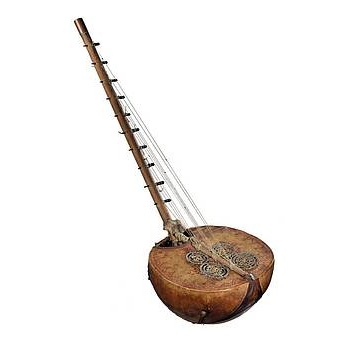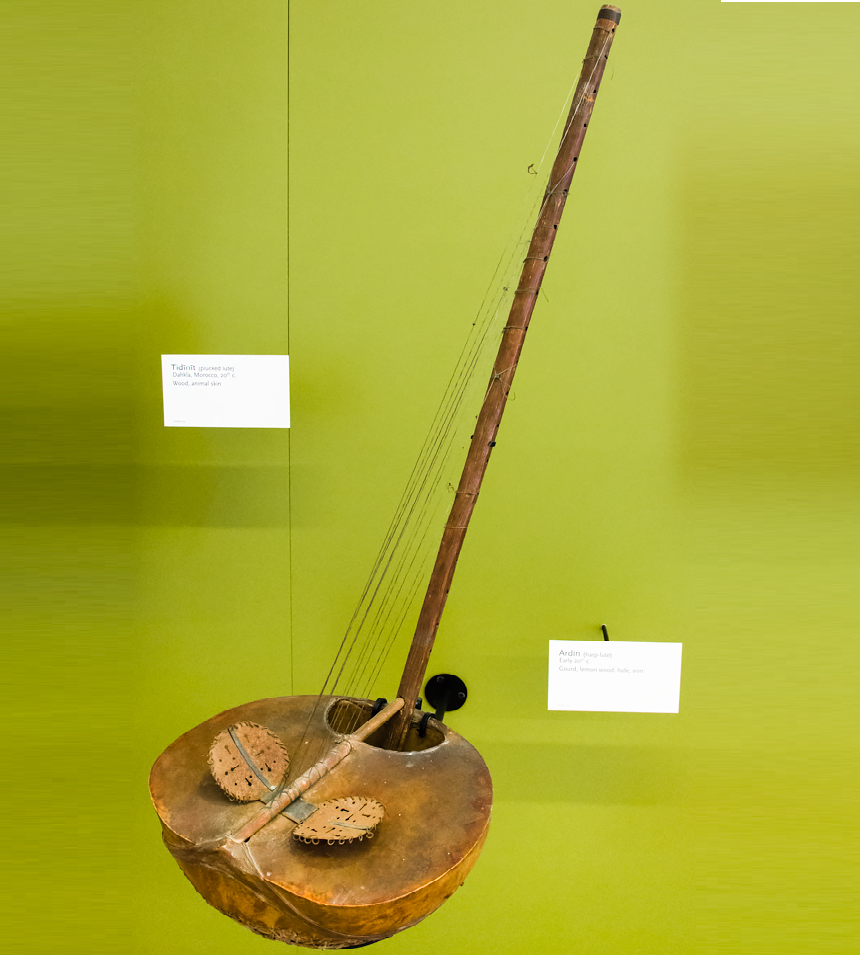Ardin
Plucked Instruments
Africa
Between 1001 and 1900 AD
Video
The Ardin is a traditional West African harp, primarily associated with the culture and musical traditions of the Mauritanian people. It is a significant instrument in the griot musical tradition, particularly played by women. The Ardin is characterized by its wooden resonator, a curved neck, and numerous strings that are plucked to produce melodic and rhythmic tunes. The instrument is typically used in ceremonial and social settings, often accompanying poetic recitations, historical narratives, and praise songs.
The Ardin is classified as a chordophone, which is a category of stringed musical instruments. It belongs specifically to the harp family due to its structural and playing characteristics. The instrument is a plucked string instrument with a resonating body, making it similar to other African harps such as the Kora. Its sound is produced by the vibration of the strings when plucked with the fingers.
Historical Background
The Ardin has a long and rich history, primarily rooted in the West African region, particularly in Mauritania. It is believed to have been developed between the 12th and 14th centuries, during a time when the griot tradition was flourishing in the Sahel region. The instrument has historical connections to the Moors and the Soninke people, playing a significant role in their oral traditions.
The Ardin’s presence in Mauritania is linked to the migration and cultural exchanges between Berber, Arab, and Sub-Saharan African groups. As a key instrument in the griot musical tradition, it has been used to convey historical narratives, celebrate achievements, and preserve the oral histories of different ethnic groups. The instrument’s significance has remained prominent for centuries, and it continues to be a vital part of traditional Mauritanian music.
Construction and Design
The Ardin is constructed using locally available materials, with craftsmanship that reflects traditional Mauritanian artistic expressions. It consists of a large, hollowed-out wooden resonator covered with animal skin, typically goatskin, to amplify the sound. The curved neck, usually made from a single piece of wood, extends from the base and supports the strings.
The strings of the Ardin are made from gut or synthetic materials and are arranged in a diatonic scale. The number of strings varies but typically ranges between 10 and 14. These strings are stretched over a bridge, which helps in transmitting vibrations to the resonator, creating a rich and resonant tone. The instrument’s tuning pegs allow for pitch adjustments, enabling musicians to modify the scale according to the musical piece being performed.
Types of Ardin
While the Ardin remains a relatively standardized instrument, there are some variations depending on the region and cultural practices. These variations primarily involve the size, number of strings, and decorative elements. Some versions of the Ardin have a larger resonator, producing a deeper sound, while others have a more compact design, resulting in a sharper, more percussive tone. The differences in construction are often influenced by the preferences of the musician and the materials available in the region.
Characteristics
The Ardin possesses several unique characteristics that set it apart from other stringed instruments. One of its defining features is its gentle, flowing sound, which complements vocal performances and spoken poetry. The instrument is known for its diatonic tuning, which provides a limited but distinctive melodic range suitable for traditional Mauritanian music.
Another key characteristic of the Ardin is its role in gender-specific musical traditions. It is traditionally played by women, often accompanying songs that highlight historical events, praise noble families, or express social commentaries. This gender association has contributed to the preservation of the instrument within specific cultural and ceremonial contexts. In terms of playing technique, the Ardin is plucked using both hands, with the musician using their fingers to produce intricate melodies and rhythmic patterns. The playing style varies based on the performer’s skill and the context in which the instrument is used, whether in a solo performance or as part of an ensemble.
The Ardin remains an important cultural symbol and a treasured musical instrument in Mauritania. Despite the modernization of music, it continues to hold a special place in traditional performances, preserving the rich musical heritage of the region. The instrument’s soothing and resonant sound ensures its enduring relevance in African musical traditions.
Construction and Design of the Ardin
The ardin is classified as an angular harp, characterized by its distinctive structure comprising two wooden components: the neck and the crossbar, which intersect at an approximate right angle. This design supports between ten to fourteen strings that stretch between these two parts. The resonator of the ardin is traditionally crafted from a calabash, a type of gourd, which serves as the soundbox, amplifying the instrument’s melodic tones. The use of natural materials like wood and calabash not only reflects the resourcefulness of Mauritanian artisans but also contributes to the instrument’s organic and resonant sound.
Playing Techniques and Sound Modifications
The ardin is exclusively played by female musicians, known as griots, who are the custodians of oral tradition and musical heritage in Mauritania. The playing technique involves plucking the strings with the fingers, producing a melodic and rhythmic accompaniment to vocal performances. The instrument’s design allows for various sound modifications; for instance, the skin belly of the ardin can be tapped or drummed while plucking the strings, adding a percussive element to the music. Additionally, metal rings affixed to the top of the neck can jingle when the instrument is played, introducing a subtle rhythmic embellishment to the sound. These techniques enable the ardin to produce a rich tapestry of sounds, making it a versatile instrument in traditional performances.
Applications in Music
In Mauritanian music, the ardin serves as both a solo and accompanying instrument. It is commonly used to accompany vocal performances, especially in the context of griot storytelling and praise singing. The ardin’s melodic capabilities complement the vocal lines, while its rhythmic potential provides a steady foundation for the performance. The instrument is also employed in various ceremonial contexts, including weddings and religious events, where it plays a central role in the musical ensemble. Its presence is essential in preserving the traditional musical forms of Mauritania, and it continues to inspire contemporary musicians who seek to incorporate its distinctive sound into modern compositions.
Most Influential Players
Among the notable ardin players is Noura Mint Seymali, a prominent Mauritanian musician who has brought international attention to the instrument. As a griot, she has mastered the ardin and integrated its sounds into her music, blending traditional Mauritanian styles with contemporary influences. Her performances showcase the ardin’s versatility and its capacity to adapt to various musical genres, thereby preserving and promoting Mauritanian musical heritage on a global stage.
Maintenance and Care
Proper maintenance of the ardin is crucial to preserve its sound quality and longevity. Regular cleaning of the instrument is essential to prevent the accumulation of dust and debris, which can affect the resonance of the strings and the calabash body. The strings, traditionally made from natural materials, require periodic inspection and tuning to maintain optimal sound production. The calabash resonator and wooden components should be kept in a stable environment to prevent cracking or warping due to changes in humidity and temperature. Applying natural oils can help preserve the wood and maintain its acoustic properties. For major repairs or restorations, consulting a professional instrument maker familiar with traditional African instruments is advisable to ensure the ardin retains its authentic sound and structural integrity.
Cultural Significance
The ardin holds profound cultural significance in Mauritania. As an instrument traditionally played by women, it symbolizes the vital role of female griots in preserving and transmitting oral history, music, and cultural values. The ardin is not merely a musical instrument but a vessel of cultural identity, embodying the stories, traditions, and artistic expressions of the Mauritanian people. Its music accompanies significant life events, rituals, and communal gatherings, reinforcing social bonds and cultural continuity. In contemporary times, the ardin continues to be a symbol of cultural pride, and efforts are being made to preserve its traditional playing techniques while encouraging its integration into modern musical contexts.
FAQ
What is the origin of the Ardin musical instrument?
The Ardin is a traditional harp from Mauritania, played primarily by women of the griot caste. It has historical roots in West African musical traditions and is closely related to other African harps. The instrument has been passed down through generations and is integral to Mauritanian storytelling and music. It remains an essential part of cultural and ceremonial performances.
What materials are used in constructing the Ardin?
The Ardin is made using a wooden soundbox covered with animal skin, typically goat or cowhide. Its frame is crafted from wood, and it features around 10 to 14 strings made of nylon or gut. The strings are attached to a bridge and tuned with wooden pegs. These materials contribute to its resonant and warm tone.
How is the Ardin played?
The Ardin is played by plucking the strings with fingers, often using a repetitive, rhythmic style. It is commonly played by female musicians while they sing or accompany storytelling. The instrument produces melodic, percussive sounds, complementing vocal performances. The player skillfully manipulates the strings to create complex patterns.
 Links
Links
References
Other Instrument
Categories



















